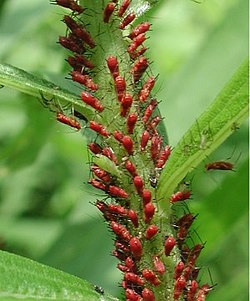Aphid
Aphids are small bugs which feed on plants. Aphids cause more plant damage than any other insects.[1] There are over 4,000 different species of aphid.
| Aphids | |
|---|---|

| |
| Scientific classification | |
| Kingdom: | |
| Phylum: | |
| Class: | |
| Order: | |
| Suborder: | |
| Superfamily: | Aphidoidea
|
About 250 species are serious pests for agriculture and forestry as well as an annoyance for gardeners. They vary in size from 1-10 mm long.
Important natural enemies include the predatory lady beetles (Coleoptera: Coccinellidae), hoverfly larvae, lacewings (Neuroptera), larvae of the aphid midge Aphidoletes aphidimyza, crab spiders, and insect-eating fungi like Lecanicillium lecanii.
Aphids are found many places on earth. Aphids are most common in temperate zones. Aphids can travel far in the air. For example, the lettuce aphid spread from New Zealand to Tasmania.[2] They have also been spread by human transportation of infested plant materials.

Aphid Media
Forewing of the early Middle Triassic (early Anisian) aphid Vosegus triassicus
Ants tending aphids and collecting honeydew secreted. A wrinkled solder beetle flies in and eats an aphid before being chased away by the ants.
References
- ↑ George C. McGavin 1993. Bugs of the world. Infobase Publishing. ISBN 0-8160-2737-4
- ↑ Landline: Scientist battles lettuce aphid.. Australian Broadcasting Corp. October 30, 2005. http://www.abc.net.au/landline/content/2005/s1493620.htm. Retrieved January 1, 2007.







